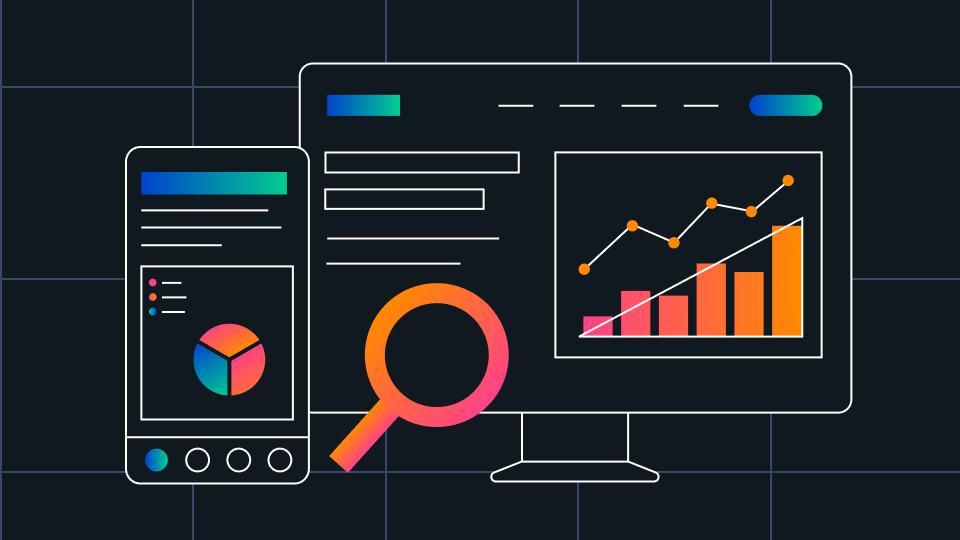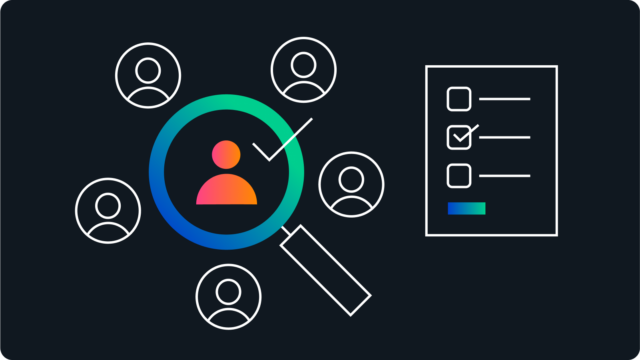4 tips to turn website metrics into actionable insights

Website metrics in isolation give us a surface-level understanding of data. Traffic volume, geographic origins, and average session duration metrics can only get you so far. Translating data into actionable insights is what leads to high-converting websites. These insights provide quantifiable metrics that can be used to back up decisions, help marketers calculate ROI, and reveal your website’s weak spots.
Web analysis requires you to think critically, identify patterns, and connect the dots. Ultimately, we rise and fall based on the quality and application of our insights. While web analytics give you clues about user behaviour, they don’t offer the “why.”
Here are three quick examples of misinterpreting web data:
- Having 200,000 visitors per day isn’t impressive if only 0.01% are converting
- Doubling your leads won’t get you very far if the majority are unqualified
- A high exit rate could just mean that your users are converting and leaving
So how do you turn analytics into insights?
It’s easy to misinterpret data when you lack context. It’s up to you to find the story behind the numbers.
What are your customers doing? Why are they behaving this way? What impact does this have on your business?
In today’s digital landscape, differentiation shines through in your digital experience. Companies that analyze their data and turn it into actionable customer insights not only improve their user experience, but also their bottom line.
By the end of this blog, you’ll better understand how to:
- Fix the leaks in your funnel
- Prioritize web pages with high conversion potential
- Identify which website metrics you should measure at each stage of the buying journey
- Avoid common web metric pitfalls
1. Figure out where your funnel is leaking money
Before getting into the weeds of data, look at your website performance and identify some quick wins. Map out 5-6 user journeys, then highlight significant drop-offs across your buyer journey to identify where you’re leaking money.
For example, consider why users may drop off at each stage of this B2B SaaS funnel:
Landing Page > Sign-Up > Free Trial > Upgrade
- Landing Page to Sign-Up: If users aren’t signing up after landing on your page, it could be because the value proposition isn’t clear or the call-to-action doesn’t stand out.
- Sign-Up to Free Trial: A leak at this stage might be due to a lengthy or confusing sign-up process or a lack of emphasis on the benefits of the free trial.
- Free Trial to Upgrade: If users don’t convert from the free trial to a paid plan, the issue could be related to a poor user experience during the trial or unclear value of the paid features.
2. Prioritize the pages with the highest conversion impact
Identify the pages on your website that play a key role in conversion and prioritize them. To find pages with high revenue or conversion potential begin by looking for:
- Discrepancies between desktop and mobile
- High-traffic pages with high bounce and low conversion rates
- High-traffic pages with high bounce and high exit rates
- High-traffic pages with slow load speeds
- Drop-offs in multi-step forms
3. Map your website metrics to your B2B buyer journey
While website metrics provide valuable information about your web experience, they don’t tell the full story. It’s your job to turn high volumes of customer data into actionable context across the buyer journey.
By strategically understanding your website metrics at each stage of the B2B buying journey, you can focus your efforts on guiding users smoothly through the process, optimizing their experiences, and increasing the likelihood of successful conversions and long-term relationships.
The “Gain Awareness” Stage
Better understand who is looking for your product or service and visiting your website. Don’t just look at the volume of traffic on your site, look at the quality of traffic. Get detailed insight into your visitors’ age, industry, job title, and region. Is your messaging, user journey, and design attracting your ICP (ideal customer profile) or a bunch of bots?
What to measure
Reach
Reach is calculated as the total number of unique users or individuals who have engaged with content, ads, or messages. Reach complements impressions by showing the unique number of users exposed to your content. It provides insight into the diversity of your audience and whether you’re reaching a broad spectrum of potential customers. Understanding your reach can help you segment your audience into user journeys.
SEO Ranking
No one will buy from you if they can’t find you. Measuring SEO ranking involves tracking how your website’s pages rank in search engine results pages (SERPs) for specific keywords related to your offering. A higher SEO ranking means your content is more likely to appear in relevant searches, which increases your chance of attracting interested users.
The “Explore Solutions” Stage
Understand how your visitors engage with your website content, specifically core conversion pages like your product, solution, pricing, and lead capture pages. Determine which pages they visit, how long they stay reading, and which page(s) they typically exit. Use this data to find opportunities for optimization to improve your user experience.
What to measure
Click-through Rate (CTR)
CTR is calculated by dividing the number of clicks an ad or link receives by the total number of impressions and multiplying by 100 to get a percentage. A higher CTR means your content aligns with your user expectations and prompts them to explore further.
Engagement Rate
Engagement rate is the total number of engagements divided by the total reach or impressions multiplied by 100. The engagement rate measures the depth of user interaction with your content. It demonstrates their curiosity about your product, service, or company. High engagement suggests that your solutions resonate with users’ interests and needs. Maintaining a high engagement rate pushes users down your funnel.
Bounce Rate
Bounce rate points to the relevance of your web pages and content. While a high bounce rate can suggest that users don’t find your content relevant or interesting, it’s important to consider the context.
For example, a high bounce rate makes sense for a single-page website that aims to provide quick information or contact details. A high bounce rate on a product page might be cause for concern, as it could suggest that the value proposition isn’t resonating with visitors or they are unsure how to take the next step.
The “Conversion” Stage
Discover the number of users engaging in activities on your website. Leverage this data to establish a link between marketing and sales, observing how website interactions convert into your business revenue.
What to measure
Conversion Rate
Conversion rate is calculated by the number of conversions and divided by the total number of visitors and multiplied by 100. It illustrates the success of your content and strategies in pushing users to take the final step, whether it’s signing up for a webinar or requesting a product demo.
Lead Quality
While not strictly a web metric, it’s important to assess the quality of the leads generated. Are they the right fit for your product? Are they likely to convert into paying customers? This might involve aligning your CRM data with your web analytics data. Add qualifiers on your lead capture forms like a drop-down field with pre-selected “business size” requirements to filter out unqualified leads.
The “Adopt Product” Stage
Gain insights into the quality of user experiences, the potential for long-term relationships, and the likelihood of organic growth through positive word-of-mouth. This stage fosters a loyal customer base and repeat business.
What to measure
Customer Satisfaction
Customer satisfaction gauges the effectiveness of your web experience. High satisfaction ensures a positive experience, increasing the likelihood of users becoming leads and your leads becoming customers.
To measure customer satisfaction, focus on tracking user engagement patterns and interactions: monitor the frequency of repeat web visits, the duration spent on each page, and exit paths.
Analyze custom segments based on active users and those consistently engaging with your sales pages.
Customer Advocacy and Referrals
To measure customer advocacy, track your social shares and referrals on third-party review sites like G2 or Crunchbase and use event tracking tools on Google Analytics to track engagement.
Remember, positive recommendations fuel customer advocacy. People trust third parties over any stat or claim you make on your website. Make sure you monitor your reviews and learn from them.
4. Avoid common pitfalls
Website metrics are not the answer to a conversion problem. Instead, they are tools that help you solve a performance problem. Avoid pouring your team’s time and energy into hitting metrics that won’t translate into business impact. Here are a few common pitfalls.
Tracking everything
While measuring website metrics is a must, tracking every possible datapoint leads to information overload. A sea of noisy data will distract you from meaningful tidbits. Focus on key performance indicators (KPIs) that align with your business objectives. For example, ‘time on site’ is a useless metric if your KPI is to increase your qualified leads. Whether your visitors spend 3:42 or 5:40 seconds on your sales page does not correlate with the amount of money you’re making. Instead focus on ‘revenue per visitor.’
- Make a list of desired actions that capture and push your users down the funnel like clicking on your get a demo button or joining your email list.
- List everything that’s gumming up your pipeline and preventing your users from taking action like 404 messages or long lead capture forms.
- Measure and track it all then compare your ‘revenue per visitor’ before and after.
Going off averages
Averages can mask valuable insights and oversimplify large data clusters. Let’s say you’re selling time-management software. If buyer #1 is a founder of a small agency and buyer #2 is a project manager for a large retailer, clumping the two together and calculating their average time on page and conversion rate doesn’t make sense. Instead, dig deeper into trends that help you understand user behaviour across segments like industry, position, or company size.
Setting unrealistic time horizons
Set an appropriate timeline for reviewing test metrics to ensure you make decisions based on reliable patterns rather than random fluctuations or long-drawn-out, polluted data. The size of your user base plays a role in determining an appropriate time frame. Websites with a large volume of traffic (5000+ users per week) and a steady conversion rate of 2% or higher generally detect significant changes in a shorter time frame than websites with lower traffic.
Piecemealing data together
Fragmented data destroys collaboration and hinders smart decision-making. Centralize your data into one repository that is accessible to all team members so that you can measure and apply data in your everyday optimization and business processes.
Not accounting for seasonality
Business seasonality skews your interpretations. Be aware of how factors like holidays, industry events, or seasonal trends impact your metrics to contextualize changes and adapt strategies accordingly. As seasons change so too does buyer behavior. Depending on your business and the global markets you play in, business seasonality could wreak havoc on your overall metrics. A B2B EdTech company may expect an uptick in traffic during August right before the start of the school season, whereas a European-based B2B vendor might expect a downturn in lead submissions during the summer months when offices typically slow down for vacation.
Celebrating vanity metrics
Vanity metrics seem impressive at first glance but in reality lack substance and value. They provide nothing more than a dopamine hit. A high volume of web traffic doesn’t mean your website is converting well. A long time on the page doesn’t necessarily correlate with high user engagement (it could mean your users can’t find what they’re looking for). Opt for insights that provide a deeper understanding of user behaviour and contribute to optimizing your website for growth.
Overemphasizing analytic tools
Human behaviour cannot be explained by numbers alone. While data is a great starting point for understanding your web user behaviour, speaking directly to them is superior. Engage directly with your customers through surveys or customer interviews to gain insights into their experiences and pain points. Use heuristic analysis and qualitative data to paint a broader data story.


